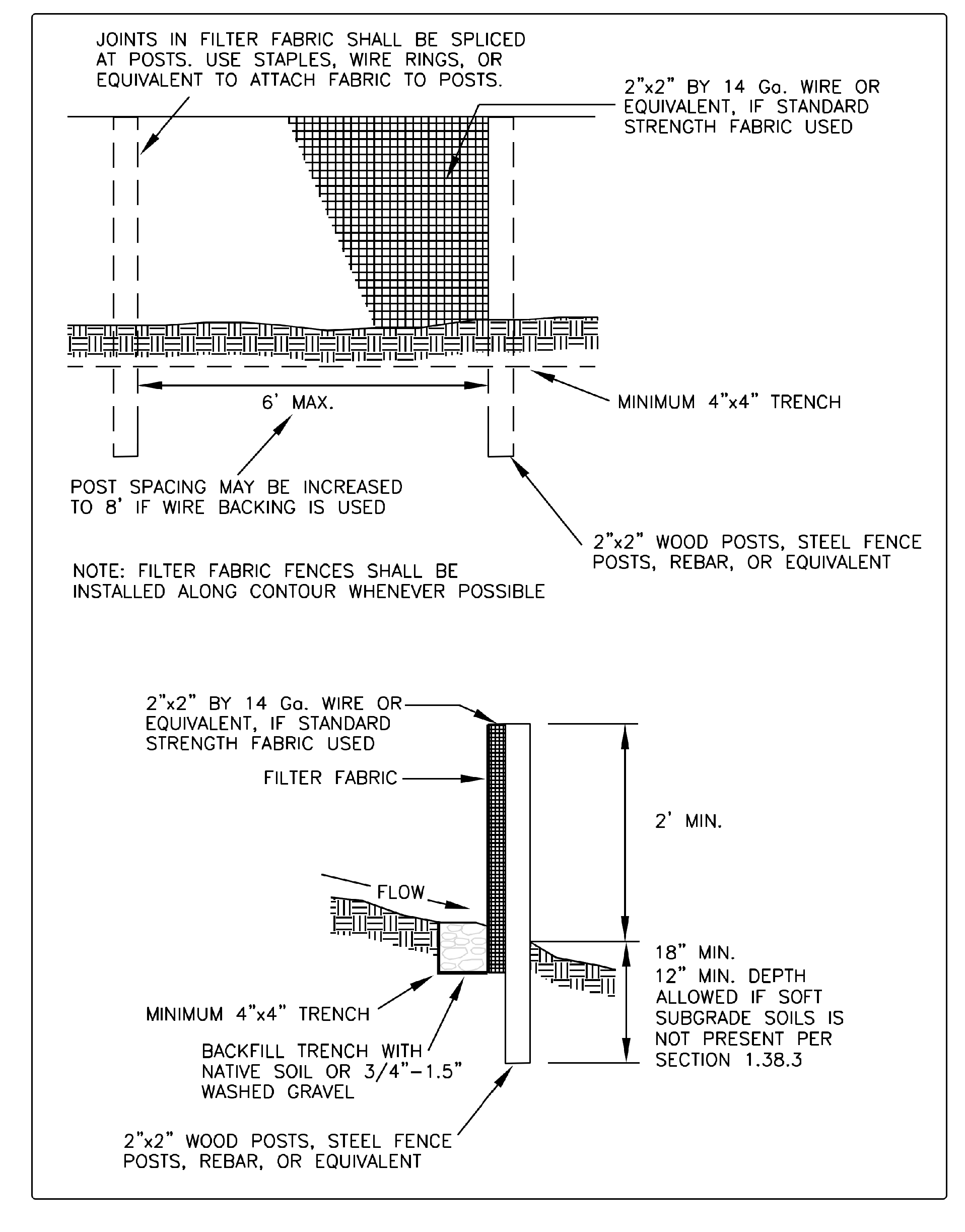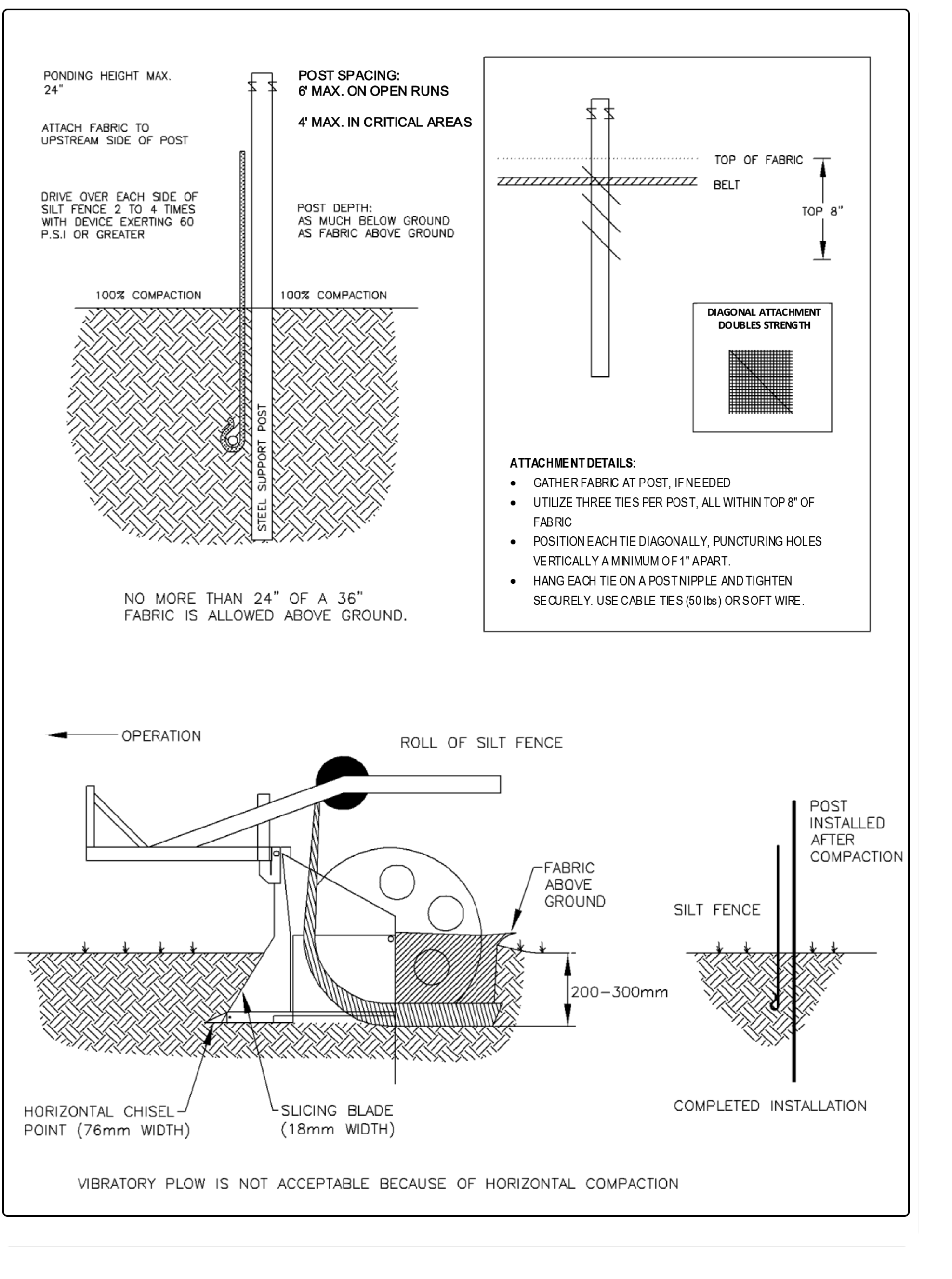Silt fence reduces the transport of coarse sediment from a construction site by providing a temporary physical barrier to sediment and reducing the runoff velocities of overland flow.
Silt fence may be used downslope of all disturbed areas.
Silt fence shall prevent sediment carried by runoff from going beneath, through, or over the top of the silt fence, but shall allow the water to pass through the fence.
Silt fence is not intended to treat concentrated flows, nor is it intended to treat substantial amounts of overland flow. Convey concentrated flows to a sediment trapping BMP.
Do not construct silt fences in streams or use them in V-shaped ditches. Silt fences do not provide an adequate method of silt control for anything deeper than sheet or overland flow.
1.38.3 Design and Installation Specifications
Use in combination with other construction stormwater BMPs.
Maximum slope steepness (perpendicular to the silt fence line) 1H:1V.
Maximum sheet or overland flow path length to the silt fence of 100 feet.
Do not allow flows greater than 0.5 cfs.
Use geotextile fabric that meets the following standards or WSDOT Standard Specification 9-33.2(1) Table 6 - Geotextile for Temporary Silt Fence. All geotextile properties listed below are minimum average roll values (i.e., the test result for any sampled roll in a lot shall meet or exceed the values shown in Table 3 - 12: Geotextile Fabric Standards for Silt Fence): Table 3 - 12: Geotextile Fabric Standards for Silt Fence 0.60 mm maximum for silt film wovens (#30 sieve). 0.30 mm maximum for all other geotextile types (#50 sieve). 0.15 mm minimum for all fabric types (#100 sieve).
Support standard strength fabrics with wire mesh, chicken wire, 2-inch x 2-inch wire, safety fence, or jute mesh to increase the strength of the geotextile. Silt fence materials are available that have synthetic mesh backing attached.
Silt fence material shall contain ultraviolet ray inhibitors and stabilizers to provide a minimum of six months of expected usable construction life at a temperature range of 0° F to 120° F.
100 percent biodegradable silt fence is available that is strong, long lasting, and can be left in place after the project is completed, if permitted by the local jurisdiction.
Refer to Figure 3 - 23: Silt Fence for standard silt fence details. Include the following Standard Notes for silt fence on construction plans and specifications:
The Contractor shall install and maintain temporary silt fences at the locations shown in the Plans.
Construct silt fences in areas of clearing, grading, or where runoff will drain prior to starting those activities.
The silt fence shall have a 2-feet min. and a 2½-feet max. height above the original ground surface.
The geotextile fabric shall be sewn together at the point of manufacture to form fabric lengths as required. Locate all sewn seams at support posts. Alternatively, two sections of silt fence can be overlapped, provided that the overlap is long enough and that the adjacent silt fence sections are close enough together to prevent silt laden water from escaping through the fence at the overlap.
Attach the geotextile fabric on the up-slope side of the posts and secure with staples, wire, or in accordance with the manufacturer's recommendations. Attach the geotextile fabric to the posts in a manner that reduces the potential for tearing.
Support the geotextile fabric with wire or plastic mesh, dependent on the properties of the geotextile selected for use. If wire or plastic mesh is used, fasten the mesh securely to the up-slope side of the posts with the geotextile fabric up-slope of the mesh.
Mesh support, if used, shall consist of steel wire with a maximum mesh spacing of 2-inches, or a prefabricated polymeric mesh. The strength of the wire or polymeric mesh shall be equivalent to or greater than 180 lbs. grab tensile strength. The polymeric mesh must be as resistant to the same level of ultraviolet radiation as the geotextile fabric it supports.
Bury the bottom of the geotextile fabric 4-inches min. below the ground surface. Backfill and tamp soil in place over the buried portion of the geotextile fabric, so that no flow can pass beneath the silt fence and scouring cannot occur. When wire or polymeric back-up support mesh is used, the wire or polymeric mesh shall extend into the ground 3-inches min.
Drive or place the silt fence posts into the ground 18-inches min. A 12–inch min. depth is allowed if topsoil or other soft subgrade soil is not present and 18-inches cannot be reached. Increase fence post min. depths by 6 inches if the fence is located on slopes of 3H:1V or steeper and the slope is perpendicular to the fence. If required post depths cannot be obtained, the posts shall be adequately secured by bracing or guying to prevent overturning of the fence due to sediment loading.
Use wood, steel or equivalent posts. The spacing of the support posts shall be a maximum of 6-feet. Posts shall consist of either:
Wood with minimum dimensions of 2 inches by 2 inches by 3 feet. Wood shall be free of defects such as knots, splits, or gouges.
ASTM A 120 steel pipe with a minimum diameter of 1-inch.
U, T, L, or C shape steel posts with a minimum weight of 1.35 lbs./ft.
Other steel posts having equivalent strength and bending resistance to the post sizes listed above.
Locate the silt fences on contour as much as possible, except at the ends of the fence, where the fence shall be turned uphill such that the silt fence captures the runoff water and prevents water from flowing around the end of the fence.
If the fence must cross contours, with the exception of the ends of the fence, place check dams perpendicular to the back of the fence to minimize concentrated flow and erosion..The slope of the fence line where contours must be crossed shall not be steeper than 3H:1V.
Check dams shall be approximately 1-foot deep at the back of the fence. Check dams shall be continued perpendicular to the fence at the same elevation until the top of the check dam intercepts the ground surface behind the fence.
Check dams shall consist of crushed surfacing base course, gravel backfill for walls, or shoulder ballast. Check dams shall be located every 10 feet along the fence where the fence must cross contours.
Refer to Figure 3 - 24: Silt Fence Installation by Slicing for slicing method details. The following are specifications for silt fence installation using the slicing method:
The base of both end posts must be at least 2 to 4 inches above the top of the geotextile fabric on the middle posts for ditch checks to drain properly. Use a hand level or string level, if necessary, to mark base points before installation.
Install posts 3 to 4 feet apart in critical retention areas and a maximum of 6 feet apart in standard applications.
Install posts 24 inches deep on the downstream side of the silt fence, and as close as possible to the geotextile fabric, enabling posts to support the geotextile fabric from upstream water pressure.
Install posts with the nipples facing away from the geotextile fabric.
Attach the geotextile fabric to each post with three ties, all spaced within the top 8 inches of the fabric. Attach each tie diagonally 45 degrees through the fabric, with each puncture at least 1 inch vertically apart. Each tie should be positioned to hang on a post nipple when tightening to prevent sagging.
Wrap approximately 6 inches of geotextile fabric around the end posts and secure with 3 ties.
No more than 24 inches of a 36-inch geotextile fabric is allowed above ground level.
Compact the soil immediately next to the geotextile fabric with the front wheel of a tractor, skid steer, or roller exerting at least 60 pounds per square inch. Compact the upstream side first and then each side twice for a total of four trips. Check and correct the silt fence installation for any deviation before compaction. Use a flat-bladed shovel to tuck the fabric deeper into the ground if necessary.
Repair any damage immediately.
Intercept and convey all evident concentrated flows uphill of the silt fence to a sediment trapping BMP.
Check the uphill side of the fence for signs of the fence clogging and acting as a barrier to flow and then causing channelization of flows parallel to the fence. If this occurs, replace the fence and remove the trapped sediment.
Remove sediment deposits when the deposit reaches approximately one-third the height of the silt fence, or install a second silt fence.
Replace geotextile fabric that has deteriorated due to ultraviolet breakdown.
Figure 3 - 23: Silt Fence
Figure 3 - 24: Silt Fence Installation by Slicing

